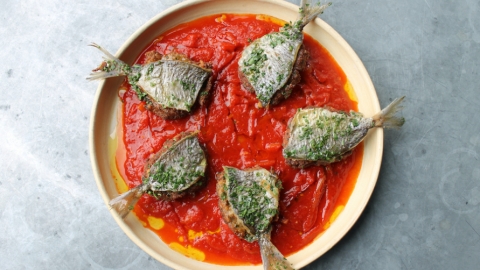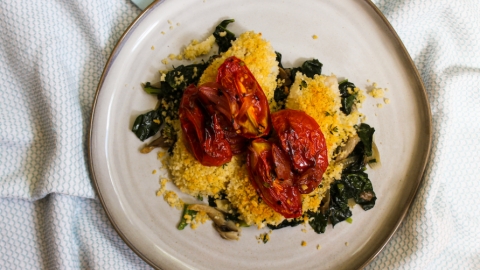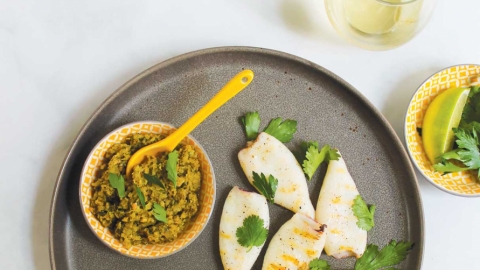Taste the Ocean State
The Case for Eating More Rhode Island Seafood
One of the things I love most about seafood is that it offers such a wide array of flavors and textures to try. Some types are sweet, buttery and delicate. Others are meaty and full-flavored. And others are briny, clean and crisp. There really is something for everyone.
While the Ocean State may be best known for its large landings of squid and quahogs, the diversity of its seafood offerings sets it apart from other coastal states. In 2021, commercial fishers harvested and landed 99 different species: fin fish such as scup, whiting, tautog, butterfish, tuna, black sea bass, fluke, monkfish, sea robin and skate along with shellfish such as quahogs, scallops, oysters, razor clams, Jonah crabs, lobsters and whelks. You could eat a different species every meal for an entire month and still not try all the options.
TOOLS FOR CONSUMERS
Now, the Rhode Island Seafood Marketing Collaborative has launched a campaign to help you learn more about and experience Rhode Island seafood, making it easier than ever to truly taste the Ocean State. For the next year, the collaborative will be promoting Rhode Island seafood while sharing resources, tools and information consumers need to find, eat, cook and enjoy more local seafood.
“The goal is to raise consumer awareness and bring more attention to local species, as well as to the fishers and seafood businesses,” says Jordyn Kastlunger, the new fisheries marketing specialist contracted through the Rhode Island Department of Environmental Management to run the campaign.
“We are doing fisher profiles that will be featured weekly on the SeafoodRI.com website, as well as on social media, to highlight different fishers and growers in Rhode Island,” she says. “We want to encourage the consumer to be better versed in what is local and why it is important to support these local fisheries versus imported seafood, which unfortunately tends to be a lot of what is being consumed in this state.”
The website also features plenty of other tools and resources consumers can utilize. One of my favorites is the weekly landings page, which shows the fish and shellfish that are caught each week. You can learn what species are in season and should be available in local markets or on local menus. And the seafood finder map helps you find local sellers.
“Consumers can click on the seafood finder map and it will show the restaurants, retail markets and direct-sales fishers that are selling Rhode Island seafood nearby,” says Kastlunger.
TASTE THE CONNECTION
“First and foremost, selling Rhode Island seafood is exciting. It’s delicious and it’s what is locally available,” explains Stu Metzler, owner of Fearless Fish Market, located on the West and East sides of Providence. “If you live here or are visiting, you want to experience what is native to Li’l Rhody— and local fish and shellfish are a big part of Rhode Island culture. It’s an amazing resource that we have here that is fun to explore and sample—and it tastes great. It’s a huge bonus that [eating local seafood] also happens to do other wonderful things in terms of the economy and the environment.”
Josh Berman, chef and owner of Little Fish food truck based in Portsmouth, built his new business around utilizing the local catch, particularly the smaller—often less popular—“little” fish.
“I created the concept for Little Fish, where we do tacos and ceviche. Those are two dishes where it is really easy to use any fish that is cut into small pieces, so it allows us the flexibility of using what’s in season and local,” says Berman. He has a mission statement on the side of his truck that reads, “Little Fish is a fresh look at our broken fast-food system. Utilizing local and sustainable ‘little fish’ we produce tacos and ceviche that are fresh, delicious and environmentally conscious ...”
SUSTAINABLE STATE
For Ben Sukle, chef and owner of Oberlin restaurant in Providence, sustainability is also a big part of why he serves Rhode Island seafood. Sukle explained that, for him, “The word ‘sustainability’ needs to refer to a way of life rather than a specific fish or shellfish. Keeping things local is the most sustainable way forward for any sort of carbon footprint and positive impact on the earth’s environment.”
Matt Griffin, an oyster farmer and owner of Salt Box Sea Farms, also touts the environmental benefits of Rhode Island seafood. “Oysters are helping to mitigate nutrient problems within estuarian waters like Narragansett Bay. When you can couple an environmental benefit with a very healthy and tasty food, I think that is a win-win-win for the consumer, the environment and the local economy,” says Griffin.
DOLLARS AND SENSE
The economic and social benefits are two additional reasons to enjoy Rhode Island seafood. “The science aside, when you are eating a local product, whether it’s seafood or a carrot, it connects you to your locale and your community,” says Griffin.
This sentiment is one of many things that inspired chefs like Sukle and Berman to open their businesses here. “Rhode Island can really connect you to the source [of local foods]. I can drive 20 minutes and be at a farm, or in 45 minutes I can be down at the docks picking up fresh seafood. It’s what made me fall in love with the state,” says Sukle, who originally came to Rhode Island from south-central Pennsylvania to attend Johnson & Wales.
And this experience is not only for chefs. Consumers, too, can connect with their food sources. Jay Swoboda is a local lobsterman based in Point Judith and one of the fishers selling his catch to the public whom you can locate on the SeafoodRI.com website.
Swoboda expressed that, for him and many of the other fishers, “catching fish and shellfish to feed people is what we are here for. It can be a struggle, particularly with this year’s bait and fuel prices, but we are still fishing and we enjoy it—we want to keep doing it—and we appreciate the people who support us.”
And then of course there is the whole freshness factor. “When you are buying a food that originates in your state, you have a better probability of it being fresh. And when people are eating something like a fresh piece of seafood, the fresher you can get it, the better the experience is,” says Griffin.
It’s not only freshness that sets Rhode Island seafood apart. It comes back to the diversity of our fisheries, the people behind them and the state’s small size. The Rhode Island seafood industry is primarily composed of smaller boats and businesses that are intimately connected to the state and its waters.
“I do believe what is special about Rhode Island seafood is that the fisheries are a bit more boutique and the quality we see tends to be some of the best in the region,” explains Metzler. “There is a higher level of quality and care in Rhode Island fish and shellfish; it’s a special thing.”
Eating local seafood could be considered the ultimate Rhode Island activity. Not only are you forming an intimate connection with the place where your seafood was produced but it’s delicious and good for you, for the environment and for the local economy. What’s not to love?
For more information on purchasing local seafood, visit SeafoodRI.com.









